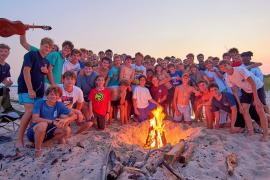View the Infographic
Each fall, the American Camp Association (ACA) requests enrollment information from camps across the country. The statistics and information allow us to chart industry trends and identify enrollment issues that camps are facing on an annual basis.
This year’s overall enrollment findings were very similar regardless of region, day or overnight camp, or camp affiliation. The overall results are considered representative of the experience of all camps participating in the survey. If a specific comparison between camp affiliations or regions is not discussed, it is because no real differences existed in the way the different groups of camps reported their answers.
Findings at a Glance
Camper enrollment continued on an upward trend in 2013.
- 76 percent of camps reported that the overall enrollment at their camp was either the same as last year or higher.
- One out of three camps reported that 2013 summer enrollment was the highest in the last five years.
- 45 percent of camps reported enrollment was at 90–100 percent of actual capacity.
- One out of four camps that reported higher overall enrollments were higher by more than 10 percent compared to last year.
Age and Gender Highlights
Enrollment for campers age nine and younger increased more than any other age group.
- 61 percent of camps that had higher enrollment in general also reported higher enrollment of campers age nine and younger.
- One in five camps that reported lower overall enrollment still had increased enrollment for campers age nine and younger. Enrollment of girls at for-profit camps increased significantly in 2013.
- One out of two for-profit camps reported higher enrollment for girls this past summer, compared to one out of three nonprofit camps. The five-year trend for enrollment of boys is holding steady.
- The percentage of camps reporting higher enrollment of boys compared to the previous year was slightly lower in 2013 (34 percent) than in 2012 (39 percent), while the number of camps having the same enrollment has increased.
Top Enrollment Issues
Camps were asked in an open-ended question to report the top two enrollment issues that they faced this past summer. The order of the most frequently mentioned issues was:
- School calendars impacted by weather-related events like Superstorm Sandy or snow days that pushed school further into the summer. This required a change in camp schedules.
- Competition from other youth programs and lower-priced camps in their area affecting recruitment and enrollment.
- Parents enrolling their children later in the year and requesting last-minute registrations.
- The affordability of camp.
- Recruiting and reaching out to new campers.
- Not having enough sessions available or facility capacity to accommodate the demand for specific groups. Young campers were listed several times in particular.
Other Interesting Findings
In general, camps had similar enrollment patterns; however, some unique differences were found.
- Camps that reported their most popular session length as being either two weeks or four weeks were more likely to be affected by changes to the school calendar. Seven-to-eight-week (or more) sessions were mostly unaffected by these changes.
- Eight out of ten nonprofit camps indicated that they were able to provide camp scholarships to campers that requested them.
- For-profit camps reported the highest percentages of returning campers, with the majority retaining over 75 percent of their campers from year to year.
- More day camps had higher enrollments for five-to-six-week sessions. Contrary to popular perception, day camps also reported the highest percentage of returning staff.
- In terms of diversity, there has been minimal change, with 76 percent of campers being Caucasian and 76 percent from middle- and upper-income families.
Key Takeaways
- While there are many different types of camps throughout the country, the majority of the enrollment patterns were similar for all camps.
- Enrollments are up. It was a good summer for the majority of camps.
- We continue to see some interesting trends around age and gender that could potentially have an impact on recruiting and planning.
This article highlighted a few of the most compelling enrollment findings from 2013. Please visit www.ACAcamps.org/research/research-reports-summaries-and-data for a full report complete with additional charts, tables, percentages, and staff recruitment information.
Enrollment highlights prepared by Troy Bennett. Troy is the ACA research assistant at the University of Utah.
Originally published in the March/April 2014 Camping Magazine.

